Related Content
Content
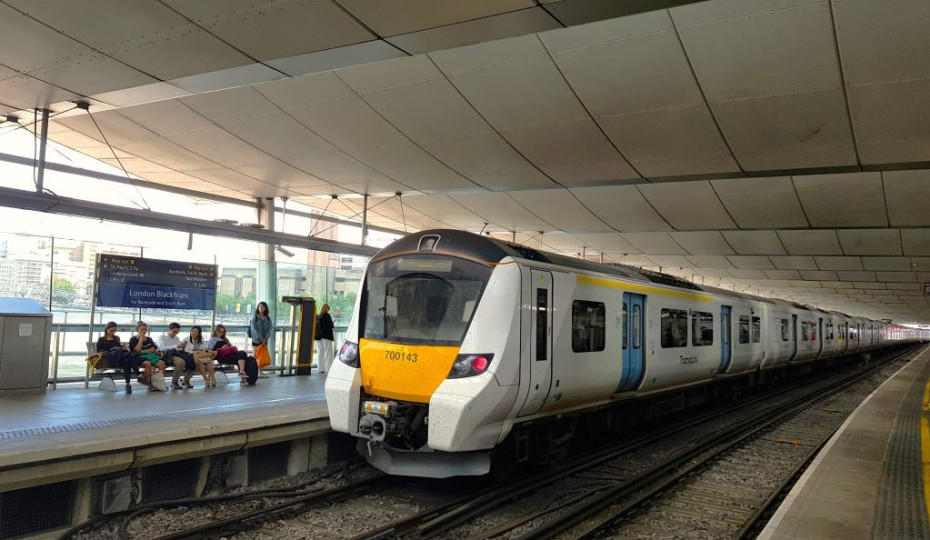
How to avoid travelling by the Underground
These insights into the alternative options to taking the Underground at London's railway terminals, can make the going easier
Share
If you will be travelling between a central London station and another location within Europe's second largest city, taking the Underground will typically be the quickest option;
However, if you will be making your way to and from a London station and:
- need a step-free route
- don't want to take long rides on escalators
- would rather not whizz through a tunnel on a busy, non air-conditioned train
- will have luggage with you
- will be travelling with small children
- etc etc etc,
then avoiding the Underground can be a much easier end-to-end journey.
Hence this guide which explains how to make the most of the alternative options.
to and from 'the Tube' lines
All of the central London railway stations used by daily long-distance trains also have connections with the the 'Tube' lines of the London Underground - the lines which cross the city’s central area and use tunnels deep beneath the streets.
They are:
- the Bakerloo which serves Charing Cross* and Marylebone* and Paddington and Waterloo*
- the Central which serves Liverpool Street
- the Jubilee which serves London Bridge* and Waterloo*
- the Northern, which serves Charing Cross* and Euston* and King's Cross and London Bridge* and St Pancras and Waterloo*
- the Piccadilly, which serves King's Cross and St Pancras
- the Victoria which serves Euston* and King's Cross and St Pancras and Victoria
- the Waterloo & City which serves Waterloo*.
*= the Tube lines are the only type of Underground line available at these central London railway stations.
Step-free access between the station concourses and the platforms that the 'Tube' trains use, is becoming the norm at the major London stations.
Though at a few locations, short flights of stairs provide the link between the escalators and the trains.
This is the situation when taking:
- the Bakerloo line to and from Charing Cross and Marylebone and Waterloo
- the Central line to and from Liverpool Street
- the Northern line to and from Charing Cross and Waterloo and when taking the Charing + branch at Euston
the other type of Underground line
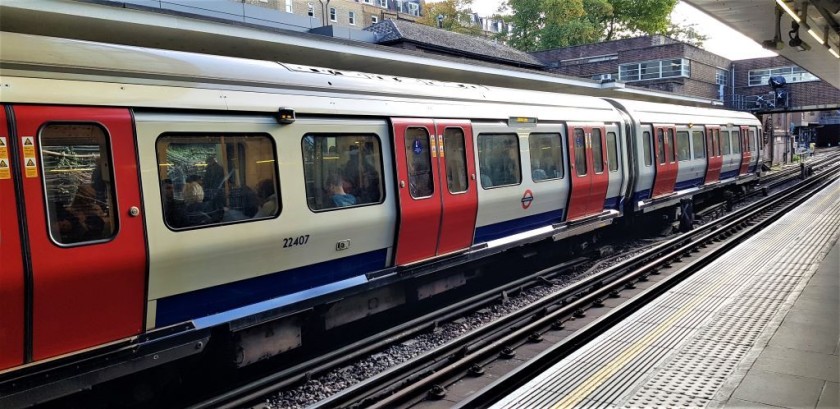
The other Underground trains are similar to full size commuter trains and they use a railway which loops around the city in a tunnel just below street level; hence they known as the Sub-Surface trains.
The Circle, District, Hammersmith & City and Metropolitan lines use this tunnel.
On the northern edge of central London, the Circle, Hammersmith & City and Metropolitan lines all serve Liverpool Street; King's Cross and St Pancras stations directly - While Euston Square station is a short walk from Euston.
Both the Circle and Hammersmith & City lines also serve Paddington
Towards the southern side of central London, the Circle and District Lines serve Cannon St, Blackfriars and Victoria.
Accessing these trains
Because these lines are not far below the surface, staircases provide most of the access to the trains at the stations.
Though lifts (elevators) are becoming more common - they’re available when accessing the trains on these lines at Blackfriars, Cannon Street, King’s Cross St Pancras, Paddington (not the eastbound District line) and Victoria railway stations.
The transfer to and from these trains is comparatively easy when the platforms that the trains use, are also adjacent to the ticket halls of the Underground stations.
(1) This is the situation for the eastbound Circle and Hammersmith & City and Metropolitan lines at Liverpool Street - this platform is used by trains:
- from Euston (at Euston Square station)
- from King's Cross
- from St Pancras
- the Circle line trains to Cannon Street, Blackfriars (connect with Thameslink) and Victoria
- by the Circle and Hammersmith & City line trains from Paddington - though taking Elizabeth line (see below) is recommended when arriving at Paddington on long-distance trains with luggage etc
(2) This is also the situation for the eastbound Circle and District lines at Paddington - this platform is used by Circle line trains from Cannon Street. Blackfriars (connect with Thameslink) and Victoria.
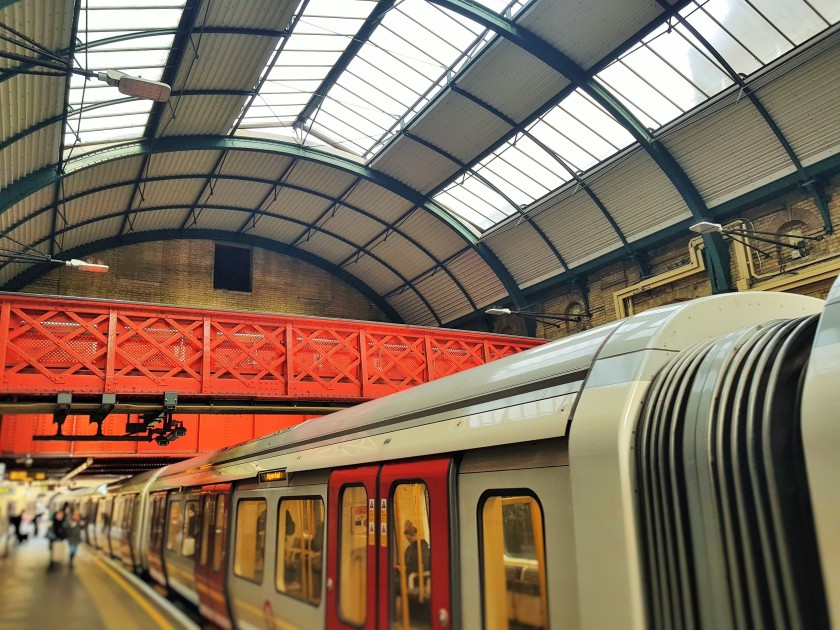
Though the access to and from the trains can be a particularly awkward at some stations; A legacy of these sub-surface lines being the world's first ever underground railways.
A footbridge (pictured above) needs to be used when accessing the westbound Circle line at Paddington - Used by trains heading to Victoria, Blackfriars (connect with Thameslink) and Cannon Street.
Another footbridge has to be used to access the westbound Circle and Hammersmith & City and Metropolitan lines at Liverpool Street - this platform is used by trains:
- to Euston (at Euston Square station)
- to King's Cross
- Circle and Hammersmith & City line trains to Paddington - hence taking the Elizabeth line is the way to go instead.
- to St Pancras
- the Circle line trains from Cannon Street, Blackfriars (connect with Thameslink) and Victoria.
Why it can be an easier to avoid taking the Underground
So the transfer between train and Underground at some central rail stations isn't step-free.
Also transferring to the Tube lines, particularly the Central, Jubilee, Northern, Piccadilly and Victoria lines when arriving by train in London is often best avoided.
The Tube stations at the mainline stations tend to be exceptionally busy and the trains are usually crowded with the people they’ve picked up outside the city centre.
Plus accessing the trains can take a while with multiple escalators and corridors to be negotiated, in the summer temperatures rise and neither the Tube trains, or the stations, have air-conditioning.
When you reach a destination
Because they’re buried far down under the city, the access to and from the Tube trains at city centre Underground stations can also be awkward.
Step-free access by lift (elevator) between street level and the platforms, from which the trains can be boarded, is comparatively rare at central Underground stations
At the majority of of the central London stations served by the Tube lines, at which the escalators link the trains to the booking hall, short flights of stairs have to be used between the booking hall and the streets.
At some of the what were once lesser used stations, lifts / elevators provide the link between the trains and street level.
So using them can be easier than taking luggage and baby-strollers etc up and down long escalators, but short flights of stairs typically provide the access between the trains and these older lifts.
Popular stations where that is the situation include, Covent Garden, Goodge Street and Russell Square.
Introducing the alternatives
However, the center of London is not devoid of conventional railway lines and now there are multiple routes which can be highly useful alternatives to taking the Underground, particularly as Contactless payment can also be used to travel by these mainline trains in the city centre.
Also, taking the bus can often be a great alternative to taking the Tube.
the Elizabeth line
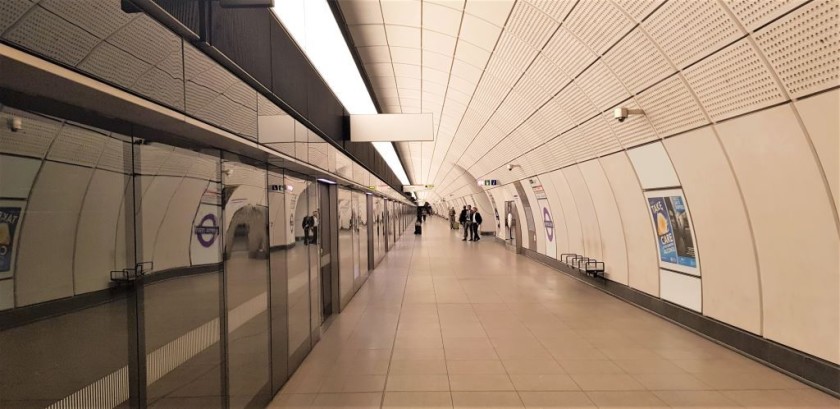
The new Elizabeth line links Paddington and Liverpool Street stations.
The access with many areas in central London has been transformed, particularly when taking trains to and from Paddington, thanks to that station’s somewhat distant location.
The Elizabeth Line station at Tottenham Court Road is within easy walking distance of The British Museum, Covent Garden and Chinatown.
Making a transfer at Stratford
Though if you train to or from Liverpool Street will be calling at Stratford, the interchange is shorter there compared to Liverpool Street - And if the lifts / elevators at Stratford are in working order, the transfer matches what's available at Liverpool Street, in terms of being step-free.
The lifts on the platforms at Stratford are towards the front of trains heading to Liverpool Street, and by the rear of trains travelling from London.
Station to Station transfers
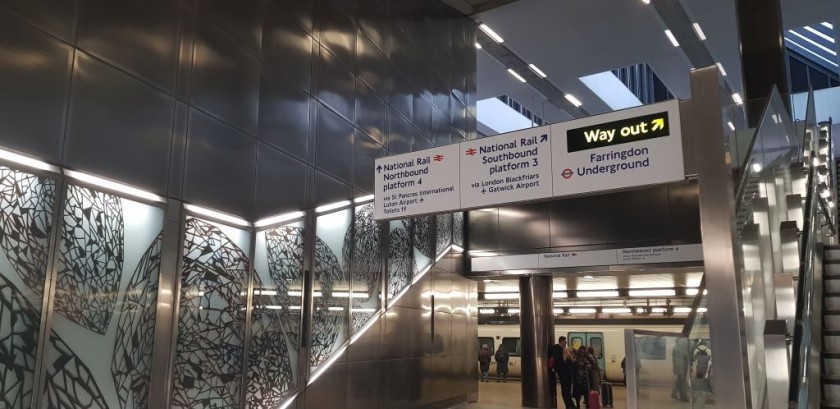
At Farringdon station the Elizabeth line connects with the Thameslink trains (see below)
So when travelling Paddington or Liverpool Street ↔ King’s Cross or St Pancras, this interchange at Farringdon provides a new alternative route, compared to travelling direct between these stations by the Underground.
The escalators which connect the Elizabeth line to the ticket hall at Farringdon, also provide a direct connection between the Elizabeth line and the platform / track used by the northbound Thameslink trains.
So the Liverpool Street to King's Cross or St Pancras transfer by a combination of the Elizabeth line and Thameslink trains, involves:
- Taking the escalator or lift down to the Elizabeth line at Liverpool Street; if you have time between trains, walk towards the other end of the westbound platform.
- Taking the escalator up from the Elizabeth line at Farringdon; there's no need to take the second set of escalators up to the ticket hall.
- Board any Thameslink train for a one stop hop to St Pancras.
- At St Pancras you can use either the elevators or the escalators to head up to the main concourse at St Pancras International station.
- If your train will be leaving from King's Cross, turn left on exiting the Thameslink street, and walk for a minute or two out of St Panrcas station and across the street.
In contrast the Underground is direct from Liverpool Street to its station named King's Cross, St Pancras, but the access to these trains at Liverpool Street involves going up and over a footbridge in the station.
Paddington to King's Cross and St Panrcas
Take the Elizabeth line to Farringdon from Paddington and you can follow the same route from there on to to King's Cross or St Panrcas.
Yes the Circle and Hammersmith & City line is direct from Paddington to King's Cross, St Panrcas; However, if you will be arriving at Paddington on a long-distance train with luggage etc, the transfer within the station to the Elizabeth line, is easier than connection to the eastbound Circle and Hammersmith & City lines.
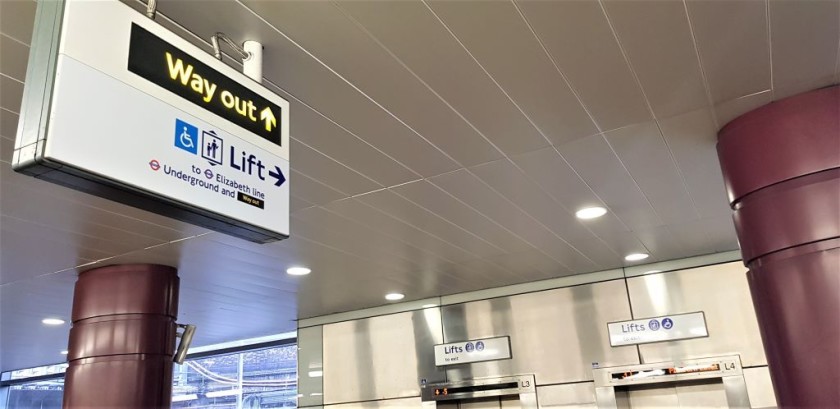
On the southbound Thameslink platform at Farringdon
In Farringdon station the lift / elevator which connects the ticket hall to the Elizabeth line, also stops on the platform / track used by the southbound Thameslink trains; Which is used by up to 16 x times per hour, making the one-station hop from St Panrcas.
The entrance to the Thameslink station in St Pancras, is a two minute walk from the Pancras Road exit at King's Cross station.
As can be seen above, the signage on the southbound platform at Farringdon, only subtly points out that the lift provides a link down to the Elizabeth line
Possibly because the lift provides a short-cut, as the other route from the southbound Thameslink trains to the Elizabeth line, involves walking up and over a footbridge in the station.
The lift is therefore busy, so for a King's Cross or St Pancras to Liverpool Street transfer, in this direction, the balance tips towards travelling direct by Underground.
King's Cross or St Pancras to Paddington
The Circle and Hammersmith & City lines provide a direct link, but the access to the Thameslink trains at Kings Cross and St Pancras is comparatively straightforward.
Then at Paddington, the Underground station that these trains from King's Cross, St Panrcas arrive at, is at the opposite end of the station to the main concourse.
In contrast the Elizabeth line platforms are beside the main concourse at Paddington - So if you will be heading to Paddington from King's Cross or St Pancras to take an onward long-distance train, and have luggage etc, the easier route is:
- Take the escalators or lifts down to platform B at the Thameslink station in St Pancras; if you have time, board towards the front of the trains.
- At Farringdon station take the lift / elevator down to the westbound Elizabeth line
- On arrival at Paddington take the escalator or lifts up to the Elizabeth line exit, from where the main concourse will be steps away over to the left.
the Thameslink trains
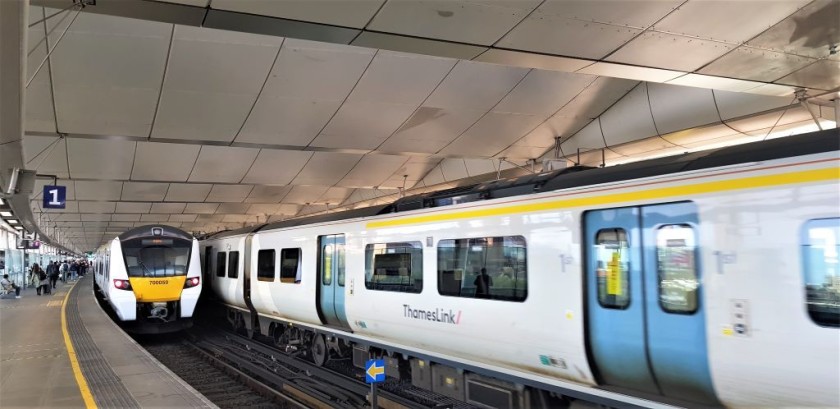
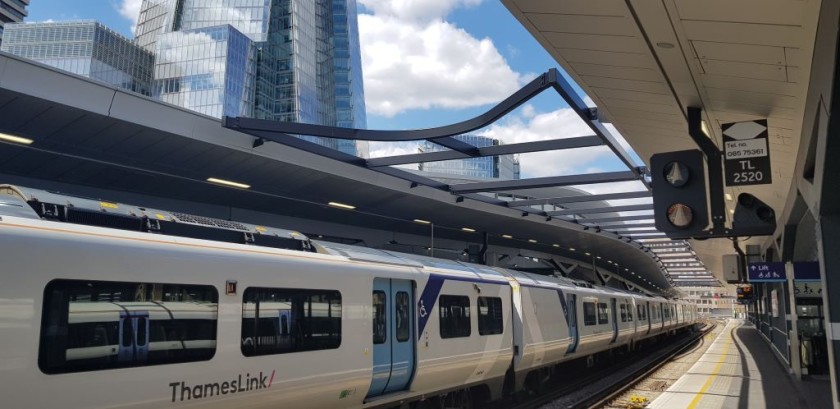
Frequent modern Thameslink trains operate on a north ↔ south route across central London, with five central London stations, all of which have step-free access by escalators and lifts (elevators).
Thameslink trains typically operate twice per hour operate on these cross-London routes which serve London Bridge (not all station calls are shown below):
- Cambridge - Letchworth - Stevenage ↔ East Croydon - Gatwick Airport - Brighton
- Peterborough - Huntingdon - Stevenage ↔ East Croydon - Gatwick Airport - Horsham
- Bedford - Luton - Luton Airport - St Albans - West Hampstead (for the Mildmay line) ↔ East Croydon - Gatwick Airport - Brighton
- Bedford - Luton - Luton Airport - St Albans ↔ East Croydon - Redhill - Gatwick Airport - Three Bridges
- Luton - Luton Airport - St Albans - West Hampstead (for the Mildmay line) ↔ Greenwich - Dartford - Gravesend - Rochester - Chatham - Rainham
There are also four trains per hour on a St Albans ↔ Sutton route which doesn't call at London Bridge; So there are typically 14 x trains per hour between St Pancras and Blackfriars.
The five central Thameslink stations
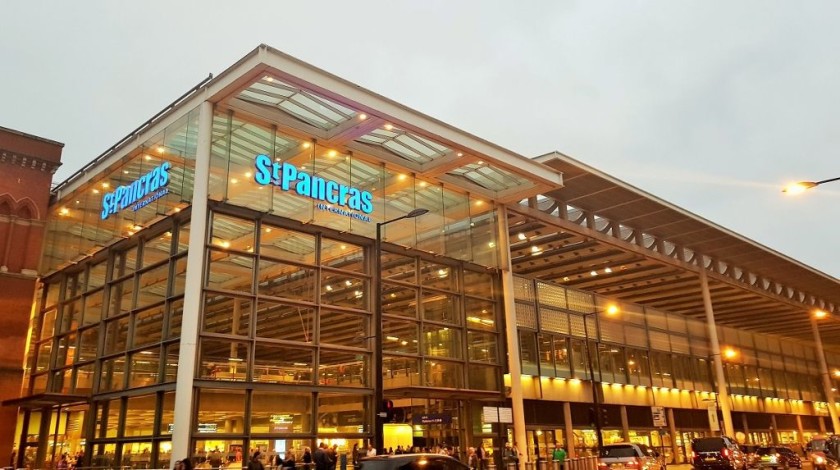
(1) St Pancras - which is on a lower level to the Eurostar terminal.
The Thameslink station is only a 2 - 3 mins walk from the arrivals area of King's Cross station.
Across Pancras Road, which is directly behind the main concourse, is the entrance to St Panrcas International pictured above; And the Thameslink station is straight ahead from this entrance.
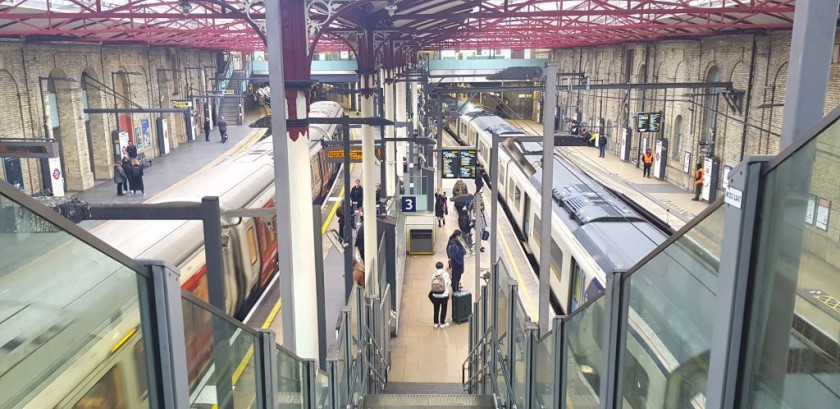
(2) Farringdon is one of central London's oldest railway stations, as the world's first Underground railway, which is now used by Circle, Hammersmith & City and Metropolitan trains, is beside the platform's used by the Thameslink trains; On the image above the Underground is on the left and Thameslink is on the right.
Step-free transfers are available between these two sets of platforms, so making the interchange between these Underground lines and Thameslink at Farringdon is much easier than at St Pancras.
Farringdon station has been extensively modernised due to its recent evolution as the interchange hub between the Thameslink trains and the Elizabeth line - see below.
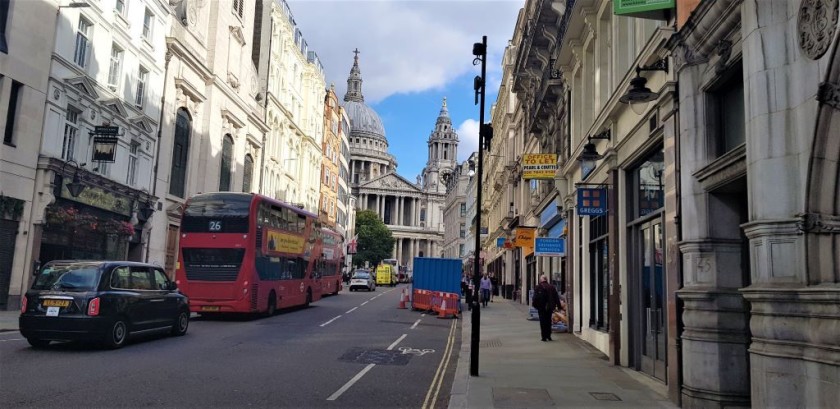
(3) City Thameslink station is closed on Sundays as it primarily serves a commercial area of London.
It has two sets of entrances / exits:
- By the front of the trains heading north from London Bridge is an entrance on a street named Holborn Viaduct, which has escalator access from and to the trains.
- At the other end of the station is an entrance on a street named Ludgate Hill, a 5 min walk from St Paul's cathedral, which has both escalators and elevators.
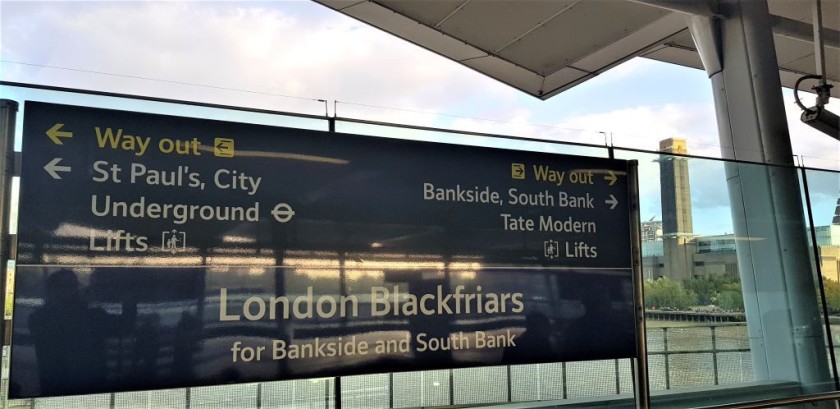
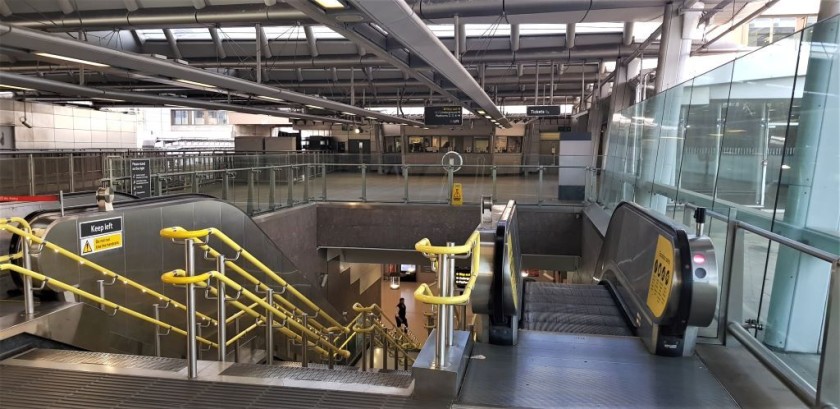
(4) Blackfriars is central London's most modern railway station, as it has been reconstructed so that it straddles the River Thames.
There is an entrance/exit on the south bank, which offers step-free access by lift /elevator to walking routes to the Tate Modern and The Festival Hall; Board by the front of the trains at St Pancras.
The main station building is on the north bank of the River Thames and it houses a step-free interchange between the Thameslink trains and the Circle and District lines of the Underground.
These two lines are not 'tube lines' and they share stations at multiple popular tourist locations such as:
- Tower Hill for the Tower of London
- Temple for Somerset House
- Westminster
- South Kensington for the museums - Natural History, Science and The V & A.
- Victoria
King's Cross / St Pancras ↔ Victoria
Hence when travelling with heavy luggage, small children etc, connecting at Farringdon typically provides an easier alternative to taking the Victoria line 'tube', when making a transfer between King's Cross / St Pancras and Victoria.
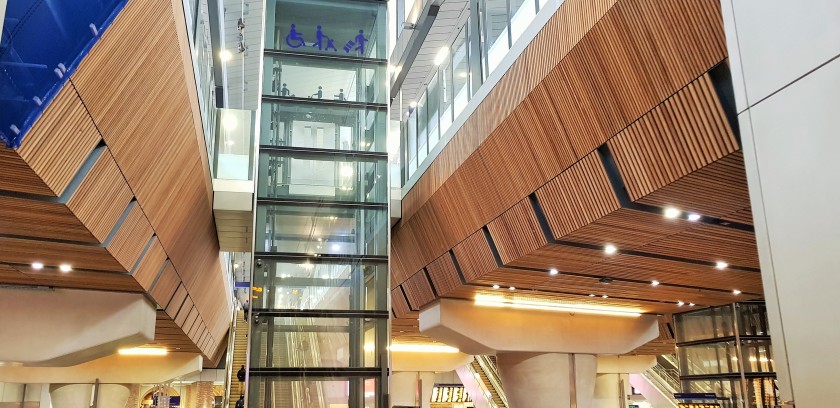
(5) Thameslink trains share London Bridge station with:
- Southeastern trains to and from multiple destinations including Canterbury, Dover, Hastings and Tunbridge Wells
- Southern trains to and from Crystal Palace; and Forest Hill, for the Horniman Museum.
A clutch of tourist destinations are located in the London Bridge area including Borough Market (best experienced on a weekend), The Shard and HMS Belfast the south side access to Tower Bridge, plus the attractions in the adjacent Bermondsey Street area such as the Fashion and Textile Museum and The White Cube Gallery, plus on weekends, The Ropewalk.
connecting between the Elizabeth line and Thameslink trains
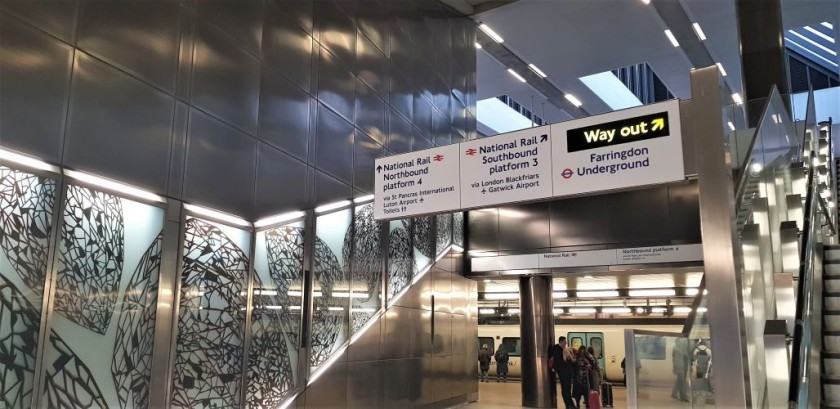

Multiple cross London routes which avoid using the Underground are now possible, because at Farringdon station a transfer between Thameslink services and the relatively new Elizabeth line is also now available.
Though the shortest routes to take within Farringdon station depend on the direction of travel on the Thameslink trains:
- The escalator which links the Elizabeth line to the Farringdon station exits, also provides the connection with the northbound Thameslink trains heading to St Pancras from London Bridge.
- The lift / elevator from the Elizabeth line, which leads to the exit at Farringdon, stops on the southbound Thameslink platform, used by the trains heading to London Bridge.
So when arriving in Farringdon on a Thameslink train from St Pancras, the lift is very much the shortest route to the Elizabeth line, despite the fact it's labelled as a link to the exit.
The alternative to using the lift when transferring from the southbound Thameslink trains to the Elizabeth line at Farringdon station, involves walking up and over a footbridge and then taking the escalator.
Routes via Farringdon
The transfer at Farringdon enables the avoidance of taking the Underground when taking multiple cross-London journeys, including
- Brighton and Gatwick Airport ↔ Canary Wharf, Heathrow Airport, Stratford (connect for Colchester, Norwich and Southend-on-Sea)
- Cambridge, Luton Airport and Peterborough ↔ Canary Wharf, Heathrow Airport, Stratford (connect for Colchester, Norwich and Southend-on-Sea)
at Stevenage station
LNER trains provide fairly frequent services between Stevenage and the likes of Leeds, Newcastle and York, while four Thameslink trains per hour usually call at Stevenage.
All four of these trains link Stevenage with London Bridge and Gatwick Airport, and two of them also serve Brighton.
At Stevenage station the trains operated by LNER and Thameslink share the same sets of platforms/tracks, so when connecting between trains there, all that’s required is to wait on the same platform for the next train you will be taking to depart.
So making the transfer at Stevenage is much easier than a King's Cross to St Panrcras Thameslink transfer.
Separate tickets per train will likely be required, which will impact on costs, but if you'll want to minimize the walk between trains and the use of escalators or lifts, it's definitely an option worth considering,
London Bridge ↔ Charing Cross
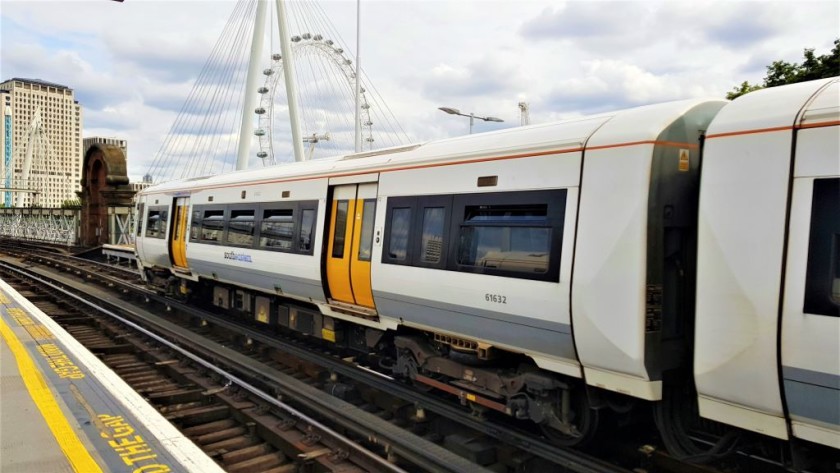
The areas around Trafalgar Square and the south side of London Bridge are popular with visitors to London, but there isn't a direct Underground line between them.
However, the easy connection is provided by the typical rail service of more than 15 x trains per hour, which link Charing Cross station and London Bridge station rail stations
All trains from Charing Cross now call at London Bridge, and the journey which has views of London landmarks, only takes 7 minutes.
Trafalgar Square is the location of The National Gallery and the separate National Portrait Gallery, plus Horse Guard’s Parade and The Churchill War Rooms, which is just off The Mall, so all of these attractions are all within a few minutes walk from Charing Cross station.
A clutch of tourist destinations are located in the London Bridge area including Borough Market (best experienced on a weekend), The Shard and HMS Belfast the south side access to Tower Bridge, plus the attractions in the adjacent Bermondsey Street area such as the Fashion and Textile Museum and The White Cube Gallery, plus on weekends, The Ropewalk.
Watford ↔ Clapham Junction
Many of the trains operated by Avanti West Coast between London and a swathe of destinations including Birmingham, Blackpool, Glasgow and Edinburgh call at Watford Junction.
Hourly trains operated by Southern provide a link between Watford Junction and Clapham Junction, which happens to have more departures per hour than any other station in Britain.
It has direct trains to and from numerous destinations including Gatwick Airport, Guilford, Hastings, Portsmouth, Richmond and Salisbury; though there are no direct trains between Clapham Junction and Brighton.
So as an alternative to having transfer by Underground between Euston and Victoria or Waterloo stations (where those trains calling at Clapham Junction commence and finish their journeys), an easier option is to travel between Watford Junction and Clapham Junction by train instead.
Both of these stations have elevators/lifts connections to all platforms, so the transfer by this route is step-free.
The end-to-end journey time will likely be around an hour longer, but it can be a good option if you have heavy luggage etc, so would rather avoid taking the Underground across the city centre.
Taking a bus
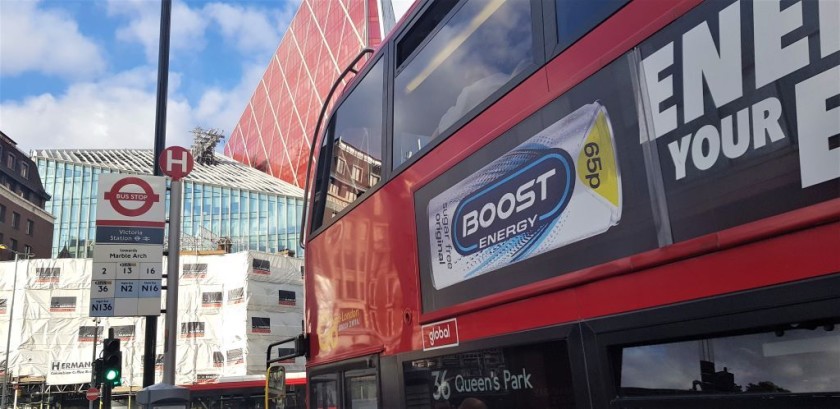
In recent years the number of bus routes (lines) in central London has been extensively reduced, but for visitors to the city this is no bad thing.
Fewer routes mean both less confusing choices; and less congestion, particularly now that on many central sections of the journeys, the buses are separated from the cars.
Bus travel has been transformed for the better in central London in other ways - Access on to the buses has become easier, they have luggage storage and also have on-board info, both audio and visual, which informs passengers of the stop they’re about to arrive at.
Plus asking the driver where you need to leave the bus is of course still an option.
Taking the bus is also cheaper than taking the Underground, the bus fare is £1.50, but a Zone 1 journey by Underground is £2.70 when using Contactless.
Good to know:
The two key things worth knowing are:
-
You can’t pay for a ride with cash, so have to use Contactless (bank cards or apps) or Oyster Cards - The Oyster cards can’t be purchased from the driver, but can be issued by machines in the Underground station at the mainline station.
-
Finding the bus you need to take at a station.
At Euston, London Bridge and Victoria there are bus stations in front of the main rail station exits; though they’re not used by most of the bus routes (lines) which serve these stations.
So at these and the other stations, multiple bus stops are scattered around the immediate ara, but most stops have diagrams which show which bus leaves from each stop; and the stops also have letters to help find them.
These diagrams, which show which bus route leaves from each stop, are also available on the relevant ShowMeTheJourney station guides.
Station to Station transfers by bus
These alternatives to taking the Underground between central London stations can vary according to the direction of travel, because they factor in how it easy it is to make the transfer to and from the buses.
So they avoid the need to take luggage and small children into the streets into the neighborhood around the station.
Something worth knowing is that tickets for cross London rail journeys will open the ticket gates at the central London stations, which the route will pass through, but they are not valid on the buses.
From Euston
(1) To Liverpool Street:
Take route 205, which will be heading to Bow.
It leaves from stop D in the bus station at Euston; It then arrives at a bus stop just across the street from one of the main entrances into Liverpool Street; escalators and a lift (elevator) is available down to the main concourse.
(2) to King's Cross
From bus stop D in the bus station at Euston, it's only a two stop ride on routes/lines 30 and 73 and 205.
(3) to St Panrcas
From bus stop C in the bus station at Euston, it’s only a two stop ride on bus routes 91 and 390.
(4) to Waterloo
Take bus route 68 which will be heading to West Norwood from stop E in the bus station.
From Liverpool Street
(1) To London Bridge:
From stop K directly across the street from the exit on the street named Bishopsgate, take bus routes/lines 149 and 388, as they terminate at bus stands directly in front of the upper level entrance to London Bridge station.
There is step-free access from here to all platforms / tracks within the station.
(2) To Victoria
From stop L directly across the street from the exit on the street named Bishopsgate, board London's most scenic regular bus route/line, the 26, as it terminates by Victoria station.
From London Bridge
To Liverpool Street:
Routes 149 and 388 leave from stop A in the bus station, which is in front of the upper level exit; the part of London Bridge station which is by The Shard.
Then the stop at Liverpool Street is by some escalators which lead down to the station concourse, from where all the trains can be accessed; a lift (elevator) is also available.
From Paddington
(1) To Euston
Take bus route/line 205 from stop E.
It's easily located if you head towards the Elizabeth line station as it is adjacent to Eastbourne Terrace, the road on which the bus stop is located.
Head towards the lift (elevator), which is behind the escalators, but instead of heading down into the Elizabeth line station, go up to street level and the lift doors will open right by the bus stop.
At Euston, the bus, which will be heading to Bow Church, will stop in the bus station directly in front of the rail station.
(2) to Victoria
Take bus route/line 36 which also departs from stop E
From Victoria
To Euston and King's Cross and St Pancras International
Bus line/route 390 goes from stop C in the bus bays right in front of the rail station.
It then stops in the bus station just in front of Euston station; and then goes on to stop on the same blocks as both St Pancras station and then King's Cross station, so no crossing over streets is required.
From Waterloo
The step-free route from the main station concourse is to head to the Jubilee line booking hall and then use its exit on to Waterloo Road, the bus stops listed below are along the road to the left of this exit.
To Euston
Head to bus stop K from where lines/routes 68 and 168 go to Euston where they will arrive in Euston at the bus station, which is directly in front of the railway station.
Bus instead of a tube into central London
Taking a bus can be a good alternative to plunging down and up the escalators, to access the deep level tube trains - these suggestions also factor in how easy it will be to find the bus stop when exiting the railway station.
So on these routes the bus will either;
- Depart from the bus station beside the rail station
- From a stop on the same side of the street as the rail station
- From a stop directly across the street from the main station exit.
Use the bus stop maps linked to each station to find the onward connection.
1: from Charing Cross
- Route 139 is an alternative to taking the Bakerloo line to Oxford Circus - from stop H in front of the station
- Route 176 is an alternative to taking the Northern line to Tottenham Court Road - from stop H in front of the station
2: from Liverpool Street
- Route 8 is an alternative to taking the Central line to Holborn and Tottenham Court Road - from stop L directly across the street from the exit on the street named Bishopsgate.
3: from London Bridge
- Route 43 from the bus stands in front of the upper level of the rail station is an alternative to taking the Northern line to Moorgate, Old Street and Angel.
4: from Paddington
At stop E on Eastbourne Terrace adjacent to the Elizabeth line entrance:
- Route 7 is an alternative to taking the Bakerloo line to Oxford Circus
- Route 23 is an alternative to taking the Bakerloo line to Piccadilly Circus and Charing Cross for Trafalgar Square
5: from St Pancras International
At stop A on the other side of Euston Road directly in front of the station:
- Route 73 and Route 390 are alternatives to taking the Victoria line to Oxford Circus
- Route 91 is an alternative to taking the Northern line to Charing Cross
6: from Victoria
From the bus station in front of the railway station:
- Route 38 is an alternative to taking the Victoria line to Green Park
- Route 390 is an alternative to taking the Victoria line to Oxford Circus
7: from Waterloo
The step-free route from the main station concourse is to head to the Jubilee line booking hall and then use its exit on to Waterloo Road, the bus stops listed below are along the road to the left of this exit.
- Route 139 and Route 176 from stop H are alternatives to taking the Bakerloo line to Charing Cross for Trafalgar Square
- Route 176 from stop H is an alternative to taking the Northern line to Leicester Square
- Route 139 from stop H is an alternative to taking the Bakerloo line to Oxford Circus; And taking the Jubilee line to Bond Street
- Route 176 from stop H and Route 188 from stop K are alternatives to taking the Northern line to Tottenham Court Road
Avoid connections between Underground lines
Buses can also often provide a direct service between a main rail station and areas of central London, which otherwise require a connection between tube lines.
Examples include:
London Bridge ↔ Liverpool Street (routes 149 & 388)
Euston and Waterloo ↔ Holborn (routes, 68 & 168)
Kings Cross/St Pancras ↔ Tottenham Court Road (route 73) and Trafalgar Square (route 91)
Victoria ↔ Knightsbridge (route 52) and Piccadilly Circus (route 38)
Waterloo ↔ St Pauls (route 76) and Islington (route 341).
Summary of how the ticketing works
All of the ticket gates at central London stations have 'readers' which enable contactless payment.
Regardless of whether you are resident in the UK, or are visiting, there are three methods of using Contactless:
- A payment app on a mobile device, including your bank's contactless payment app, or the likes of Google Pay, Apple Pay, or Samsung Pay.
- A debit / credit card as long as it has the contactless symbol
- An Oyster card (you touch in and out as you do when using Contactless).
Good to know about using Contactless
- The system works by touching in and out.
- When using bank cards, take care to use the same card when touching out at the end of a journey, as you did when touching in at the start.
- You have to pay with Contactless on the regular red buses, you cannot pay with cash.
- When travelling by the Underground or Elizabeth line, you can save 10 - 20p per journey by paying with a banking app / card instead of an Oyster card.
- Making a Contactless payment is cheaper than buying a ticket from a station counter or machine - the price difference is usually at least 50%!
More info is available on the general London by train guide.

Simon Harper
I wanted to share my passion for train travel and explain how anyone can take the fantastic journeys I have taken.

This is one of more than 100 train travel guides available on ShowMeTheJourney, which will make it easier to take the train journeys you want or need to make. As always, all images were captured on trips taken by ShowMeTheJourney.
This second version of ShowMeTheJourney is exciting and new, so we are genuinely thrilled that you are here and reading this, but we also need your help.
We’re striving not to let anything get in the way of providing the most useful service possible, hence a facility has been set up with DonorBox which can be used to support the running costs and make improvements.
Instead of advertising or paywalls, your financial support will make a positive difference to delivering an enhanced service, as there’s a lot of ideas which we want to make happen.
So if you have found the info provided here to be useful, please consider saying thank you.



